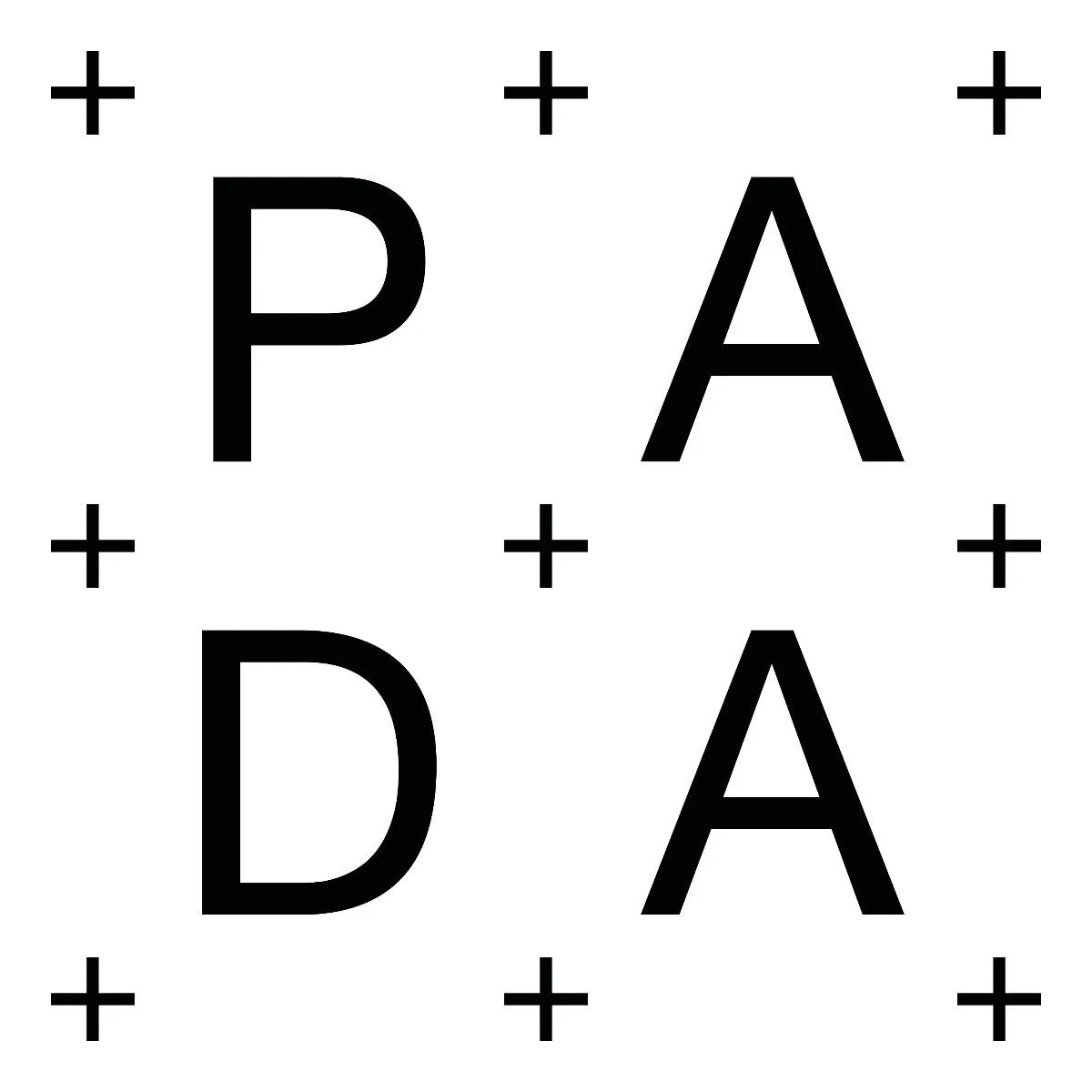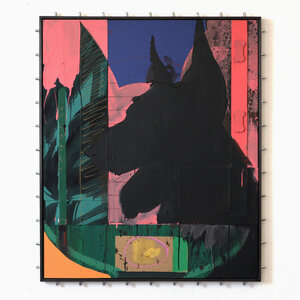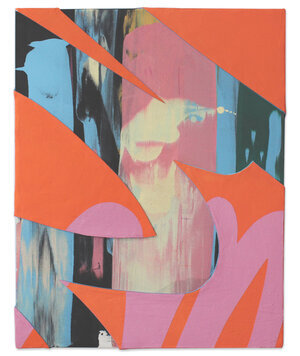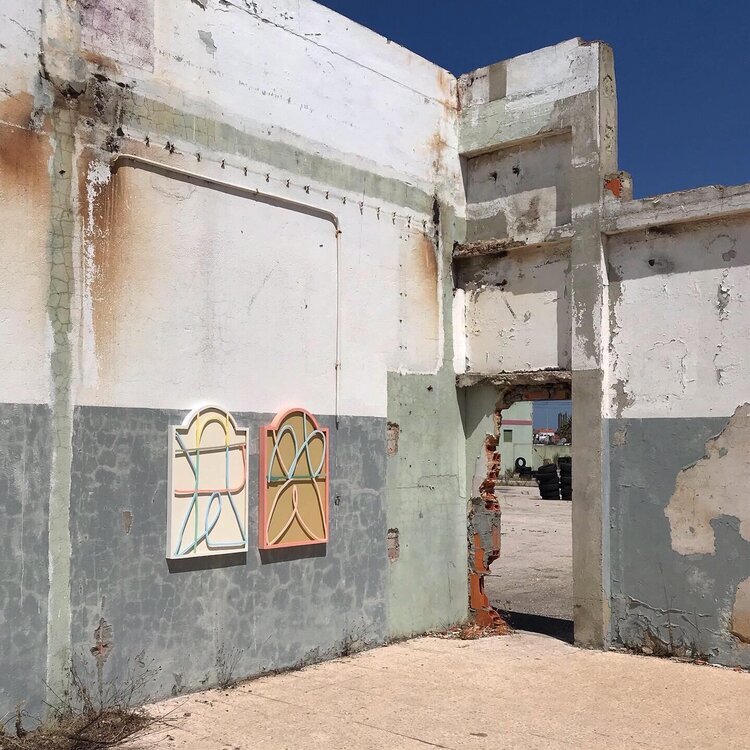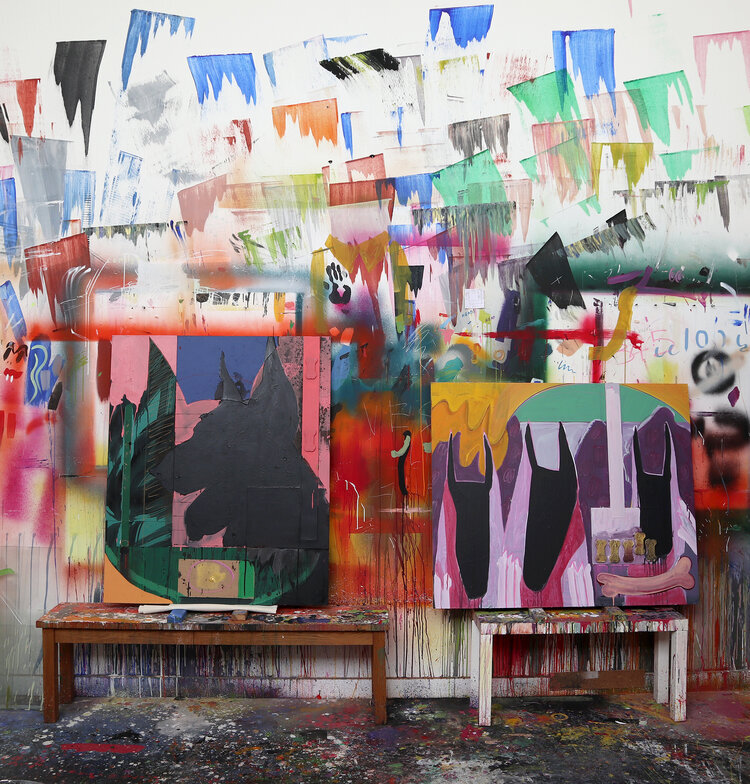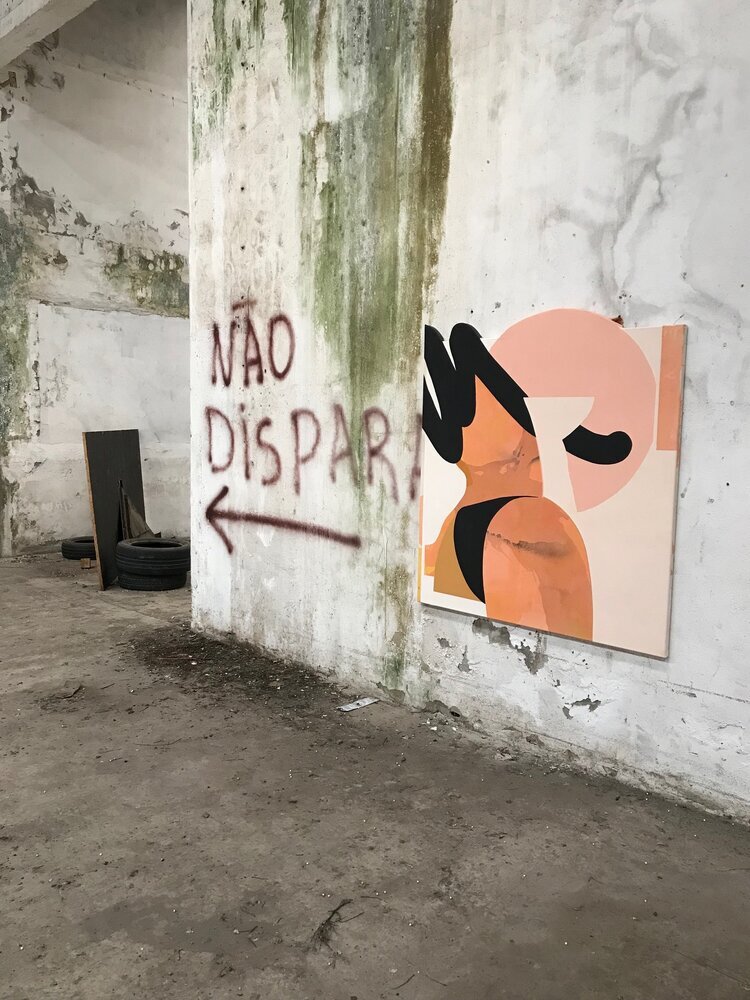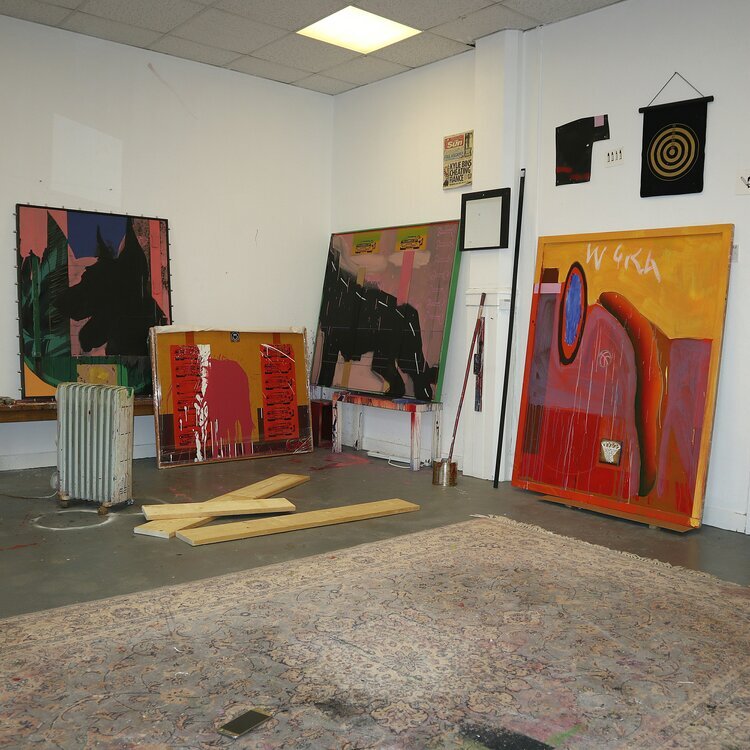LONG RANGE STUDIO VISITS
Kathryn Macnaughton and Felix Zandt
This conversation brings together Kathryn Macnaughton and Felix Zandt, they talk about their inspirations for paintings, techniques they use and methodologies they follow. Readers can dive into their practices and understand the multilayered works they create.
Felix Zandt, Modern Sports, 120 x 100 cm mixed media, 2020
Just as the tasks we partake in on a daily basis can be either liberating or controlling, the paintings present a labyrinth of avenues that can lead us to open possibilities or premature endings. Felix Zandt employs many techniques through his application of paint. Spraying, pouring, dragging and masking are some of the methods used to play with the spaces that are suggested in the works.
Kathryn Macnaughton, REBOUND, Acrylic on Canvas, 24x30in, 2019
The individual components of Kathryn Macnaughton’s work require their respective approaches. The underlying washes require a freestyle approach. The graphic elements require the artist to be detailed and meticulous. In this, she sees that her process is at times delicate, and in others brutal. Macnaughton is motivated by the desire to arrive at a visual balance within this seemingly chaotic approach.
FZ: So great to look through your images - Thank you for sharing! I have my own memories and photographs from PADA and Barreiro. When you see moments from someone else’s time there you really appreciate PADA as something that is constantly changing and almost modular. I stop thinking about it as a moment that has passed and I start to think about what could happen if I were to return. Are you considering going back? I feel like timing makes such a difference.
KM: Yes. I completely agree. I was lucky enough to be there for 3 months. July, August, and October. I was living in Lisbon in September, just taking a break and travelling a bit. It was nice to come back to Pada with a fresh perspective. I would have stayed over 3 months. It felt like there was never enough time! PADA was wonderful. I met some exceptional people, and I really enjoyed sharing a space with other artists. My art practice in Toronto is a little isolated. I work in a studio by myself. To be honest, I was nervous about people looking over my shoulder into my space while I worked, but it didn’t bother me at all. The artists respected each other's privacy, and I always enjoyed my friends coming by to give me some feedback. It was very helpful. I’m now back in Toronto, REALLY isolated in my studio, but thankful I have this space. I was planning to visit this month, but due to Covid, they canceled my flight. I’ll be on the first flight to Portugal, the second things are back up and running.
How was the experience for you? How many months did you stay? Where are you based out of right now and are you working right now?
Kathryn Macnaughton, Paint Factory view, 2019
FZ: That’s great you plan on revisiting. I hope to do the same but maybe as part of a longer journey. My stay at PADA was a month long ‘Turps’ mentored program. It had a loose structure to it which we all helped to curate so it felt new and experimental - which was a fun process.
Working in front of other people seems to be a different experience for everybody. I personally don’t mind the act of working in front of others and I think it’s something I had to be comfortable with when I painted as part of a team in theatre/film studios. But at the same time it definitely affects the kind of work I produce. I would say that I try to resolve problems faster than usual - maybe I don’t want to leave a bad painting hanging on a public wall for too long. I did rush some of my works in Barreiro and potentially could have even spent a bit less time painting. Maybe that is a pressure that can come hand in hand with the time constraints of a residency setting; in normal life if I’m stuck in the studio I’ll leave it for a while, maybe a month.
So currently I’m in my studio in Glasgow, Scotland and I’m very lucky that I can continue to work safely. Your studio in Toronto looks great. It’s impossible to not notice the floor! Obviously your floor is an ever changing record of paintings being and gone (I have a similar situation unfolding where I work). I do find the floors of work spaces enjoyable to look at; and it really maps out the performative element in painting. Especially of larger works. It can be so physical and sometimes you can only see the evidence of that movement in the surrounding space. Everytime I move to a new studio I find it hard to erase the floor and it usually requires some encouragement from a landlord.
Are you refreshing your walls for viewing purposes or are you mostly working on the ground? I should probably have a refresh as I can barely see what I’m working on currently.
KM: Glasgow is on my travel list! They have such a great art scene there. Did you go to school there? I moved into my studio when I returned from Portugal and the floors got like that pretty quickly. All the messy parts of my process happen on the floor, so my walls aren’t too bad. I haven’t refreshed them and I have a wall that I mostly just used to hang the work, so I don’t think it’s necessary. I sometimes like the hints of colour on my wall next to my work. It can conjure up some ideas. There’s two stages to my process. The canvas starts on the ground. I pour and push paint around. Once I’m satisfied with the wash, I apply the clean shapes to the canvas on the wall. Do you go back and forth from the floor to the wall?
Your work looks very physical. I see some splatters and drips which makes me think most of your mark making happens when it’s mounted on the wall. What’s your process?
Felix Zandt, studio view
FZ: Yeh I did go to school here, and you’re right there are so many great artists in Glasgow. Live performance and sonic artforms really seem to have been the focus in recent years but lately I have felt a resurgence in painting again which I hope keeps on growing. There’s room for a lot more of everything.
It’s interesting to hear how you make your work and it sounds like there is a method to your process. I can imagine that inventing a structure and establishing boundaries can help focus the work and potentially push you deeper into a certain subject. I find this an interesting topic to think about as a painter. I definitely have tried following a set of guidelines in terms of methodology. Whether it be a certain colour palette or range of tools I might use for mark making. Recently I feel like I have tried to deconstruct this however and let my studio practice become a bit more of a mash up. I love it when the surface I’m working on starts to feel like a magnet that is collecting marks and objects from around the studio. Sometimes those combinations are unexpected and so the direction changes. I’ve always enjoyed the conflict between structure and chaos and that definitely still exists in all of my paintings.
Is this a subject that resonates within your practise? When I look at your paintings and imagine how they are made it feels like there is a chaotic moment followed by an editing process that is more controlled.
KM: Oh yes. Structure and chaos is definitely a part of my practice. I have more of a chaotic approach in the first stages. Pouring paint and creating the wash. The second stage is a reaction to the wash. I “erase” the parts I don’t like or I guess you could say, if there’s a part of the wash I find interesting, I’ll crop into it creating a composition that is a reaction to the wash. It feels like there isn’t really a method or formula because I would apply anything on top that seemed appropriate. Occasionally the wash is too good to cover at all.
I really love the collage elements in your work. I see a little Robert Rauschenberg. Is he an influence? Are you using found materials and reused scraps to create the collages? Is that a starting off point for the work?
FZ: There’s definitely something captivating about the mark making that takes place when paint is reduced to a liquid form. Is that why you use water based paints? It’s funny you mention Rauschenberg because although he’s not an artist I think about currently, he was the first artist that really opened up my understanding of what a painting can be. I was 15 when I bought a copy of the book ‘Combines’ which really presented his sculptural works as labyrinth puzzle boxes of mythology and social-political commentary. I was very into it as a teenager and it must have stuck with me.
The collage materials I include are generally designed by myself rather than ready-made and sometimes they are remnants of my day job as a picture framer. It started when I got some bits of ply laser engraved so that I could use them to make woodblock prints. I instantly fell in love with the blocks as objects and instead of printing with them I glued them onto my paintings. It really blew open the building process of a painting for me and I suppose a bit like Rauschenberg’s combines it allowed me to introduce multiple narratives to a single piece of work.
When I look at your paintings I feel like there is an evident nod to digitalised mark making. Are all of the forms you make reactionary or do you feel like there are certain shapes that recur in your pieces?
Kathryn Macnaughton, Paint Factory view, 2019
KM: I feel the same about Robert Rauschenberg. In my late teens I saw his retrospect at the MOMA and I definitely looked at painting differently after that. I was a freelance illustrator for 8 years before I started painting full time. I'm glad you can notice the digital aspect of my work. As an illustrator, my work was digital collage, not so far off from what I'm creating now. I take a photo of the wash and bring it into the computer to play with colour and composition that will lie on top. Most of the forms are reactionary because it's hard to make the form work again with relation to the wash. I sometimes try to reuse existing shapes, if I think it works well in a previous piece.
So what are you working on right now?
FZ: I think the use of computer editing software has really opened a lot of doors for the way artists can think about their work. I always photograph everything when I leave the studio each day. I like being able to look back at something if I get an idea late at night and likewise I can put an image on the computer or even a drawing app on my phone and make notes on top of it. Right now is a very busy time, as I’m talking to you I think it’s probably useful to note that as well as being in the midst of a global health crisis. There is currently a long overdue global focus on the humanitarian crisis that is racism. Everyone is being asked to look at their own privilege and question how they can personally change and help change. Currently I’m trying to reconsider how I can use my liberties as an artist. Although my work has political themes I think it is true that making work can sometimes feel slow and unequipped to support those in need. I’ve been in conversation recently with a group that is trying to help artists find ways to donate to anti racist causes which is called Artists Support Black Lives. They’re using instagram as a tool and I recommend any artist that wants to help fund anti racist organisations to go check it out. There’s been some real shifts in the way artists can work, promote and sell recently. One of the great things that has come about I feel is that artists have regained alot more control from the gallerists and art fairs. I think it's still changing and so I’m really keen to see where it goes.As an artist that has a strong online following do you find it empowering or do you feel a greater pressure to present yourself to an audience? Are you working on a specific project currently?
KM: Yes, that’s so wonderful. I really enjoy seeing artists on social media take part in raising money for the BLM movement. The shift in how we share, listen, learn and take part using social media has become so useful. To be honest, even though I have lots of followers, I’m terrible at social media. I’m rarely active on it, but during these times it’s important to stay engaged and find a balance without getting completely sucked in! I’m working on it. At the moment, I’m painting a new body of work for a solo show in September at Beers London Gallery in London.
Felix Zandt, studio view, 2020
For more information and to see more examples of work visit
